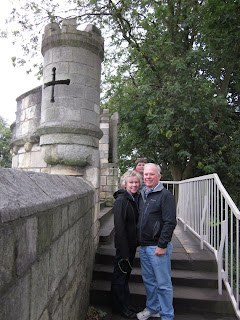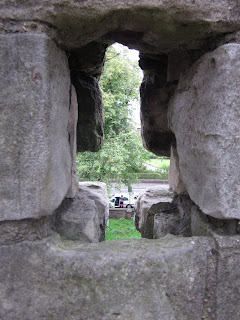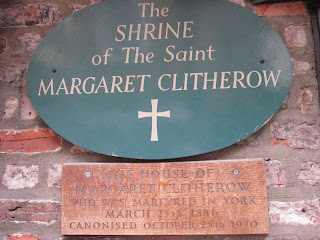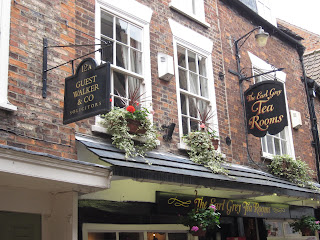 |
| York Minster |
The day after Blenheim Palace, Mom, Dad, Isaac, and I went off to York. York is another one of my favourite places to visit. It is a very historical city. In 71 AD, York was known as Eboracum; it was a Roman provincial capital and was the northernmost city in the Roman Empire. So when you go to York, you know you are going to see some really old stuff! Constantine was proclaimed to be the emperor of York in 306 AD. In the fifth century, a Roman emperor sent a letter to England that explained that the Roman empire was crumbling and that England would be on its own. Shortly after that, York became Eoforwic, the capital of Northumbria - an Anglo-Saxon kingdom.
A church was built in York in 627, and the town became known as a place where Christian learning occurred. Later the Vikings took over control of the town, and from the 9th through the 11th centuries, York was a Danish trading center called Jorvik. In 1066 - my friends and yours - the Normans invaded and conquered the city. They destroyed it and then rebuilt it, fortifying it with a castle and the walls that still stand around the city. Due to the historical nature of York, we have learned a lot about the city and its importance throughout our British Studies class.
 |
| Stained glass window inside York Minster |
In Medieval times, York became known for its wool trade and then became England's second city. Henry VIII used the city's Minster as the Anglican Church's northern capital. The religious importance of York continues today as the Archbishop of York in the Anglican Church is second only to the Archbishop of Canterbury - if you remember, I talked about the Archbishop of Canterbury when I blogged about our trip to the Dover Castle.
In the Industrial Age, York became the railway hub of northern England. When it was built, York's train station was the world's largest station. Their train station remains one of my favourite train stations. The arched ceilings and metalwork within the structure itself are totally amazing.
York's leading industry today is tourism. Once you have visited York, you will quickly find out why tourism is the leading industry - there is just so much to see and do there!
York Minster church is the largest Gothic church north of the Alps. Because it is the seat of a bishop, York Minster is also known as a cathedral. Although Henry VIII destroyed England's great abbeys, York Minster was spared because it was not part of a monastery. The church comfortably seats 2000 people - it is a sight to see. I have not yet gone inside York Minster to check out the whole place. My goal is to actually get into the church the next time I go to York...maybe Greg will go with us in a couple of weeks :)
One thing I have learned about British history is the close relationship between church and state. The Anglican Church (the Church of England) was born in 1534 when Henry VIII declared that he was the head of England's Catholics. In this statement, he disowned the Catholic faith and pushed Pope Clement VII out of England. All this basically happened because Henry wanted to divorce his wife to marry Ann Boleyn. Because the Pope wouldn't grant his divorce, Henry decided to overthrow the Pope. Henry eventually divorced his wife, married Ann, and they had a daughter, Elizabeth, who would one day become Queen Elizabeth I.
Henry still regarded himself as Catholic - he just wasn't Roman Catholic - so the Catholic mass and the Anglican service are very similar - even still today. Henry's son, Edward VI, instituted many of the changes that Reformation Protestants brought on in many European cities. There was an emphasis on preaching, people actually began to read the bible, and clergy were allowed to marry. When Edward died, his sister, Mary I, took over in the middle 1500's. Being Catholic, she changed England back to the Roman Catholic Church. She earned the nickname "Bloody Mary" because of her brutal suppression of the Protestants. Now I know where bloody Mary's came from - now if I could just figure out the beer chaser part of the drink :) This didn't go over too well with the English, and when Elizabeth I succeeded Mary with the throne, the English broke away from the Roman Catholic church one more time.
 |
| View of the spires from the city walls |
 |
| A restaurant outside of York Minster - Bennett, I was thinking of you on this trip! |
In York, an important thing to remember is that a "bar" is a gate and a "gate" is a street...I know it is confusing, but it is a Viking thing :) One of my favourite things to do in York is to walk the walls around the city. The walls were originally built by the Romans and then were expanded by the Normans in the 12th century to assert control over northern England.
 |
| One of the bars leading up onto the wall |
 |
| Mom and Isaac walking along the wall |
 |
| More pictures on the wall - where's Isaac? |
 |
| A look through a hole in the wall |
I took the next couple pictures for Mike and Myra (Greg's boss and his wife), who are master gardners - I really loved this garden - even in the cold gray day we had in York, the colours were so vibrant, and I was thinking of their gardens. What I find most amazing is that the British are able to have incredibly beautiful spaces without a whole lot of land...how do they do it?
 |
| I think this is the Monk Bar behind me |
The views from different parts of the wall are just amazing. You can see York Minster just about wherever you go. Also throughout the wall there are square notches at the top of the walls called pivots that were used to provide cover for archers who were defending the city.
 |
| The moat |
Now you may wonder why the moat doesn't have water in it. Well the best I can tell is that the majority of moats at least in England are dry moats - what this means is that they didn't have water. However, the land and ditches were so steep that they protected the walls of a city or a castle quite well. I am beginning to think that wet moats are a creation of Hollywood - I guess I'll have to keep searching for a moat with water in it :)
 |
| A blue door |
It seemed like everywhere we went over the past few days, we ran into bright blue doors. I am not sure the significance of the blue doors, but Mom is thinking she needs to paint her door blue - I think I need to find out why the doors are blue before we start painting ours this colour :) As we continued down the wall and through the city, we ended up running into the York Food Festival. It was quite the experience - there was food everywhere!
 |
| Checking out the hot sausages from Germany |
 |
| Chocolate kabobs - I think Mia might have some competition in the dessert kabob category! |
After going through the food fair and a Marks and Spencer, which is a grocery store combined with a really nice department store, and watching the Ryder Cup for a few minutes in the men's department, we decided to continue our journey through the shambles. The shambles is a really cool place in York. Shambles comes from the word "shammell" which means a butcher's cutting block. In the 16th century, this part of York was busy with butchers and any kind of red meat. People lived above the stores and all the garbage was flushed down the street to a really mucky pond at the end of the road. This was a favourite place for the dogs and cats of York to hang out. Today, the Shambles is known as one of the most haunted places in England...I haven't been there at night to check it out yet :)
 |
| A typical view down the Shambles |
The thing that amazes me every time I see the Shambles is how the houses come into the street as they were built up. I am not quite sure how they remain standing - and if you look carefully, in the Tudor building behind me in the picture below, the houses and buildings actually sag...

 |
|
As we walked through the Shambles, we came across the shrine to Saint Margaret of Clitherow. St. Margaret is the first woman who was sentenced to death under the rule of Queen Elizabeth. She was born in Middleton, England in 1555 to Protestant parents. She was good looking and had a great personality - history says she had good wits and like to have fun - sounds like my kind of girl! In 1571 she married John Clitherow, a butcher. Margaret and John had 3 children (Henry, William, and Anne) and Margaret converted to Catholicism. She wanted her son to go to a Catholic school in France, and she was known to pray for her 1 1/2 hours every day. She also fasted 4 days a week. When laws that forbid people from attending Roman Catholic masses were passed, St. Margaret continued going to church. She was imprisoned many times because she would not go to Protestant services. Her zeal for her religion led her to harbor fugitive priests. When the British found out what she was doing, they took her to trial and tried to make her made her denounce her faith. St. Margaret was totally committed to her Catholic faith and would not budge. So she was ordered to be pressed to death on March 25, 1586. She was stretched out on the ground, with a sharp rock on her back. A door with a bunch of weights was placed on top of her and her bones started to break. She died within 15 minutes. The feast day of Saint Margaret is March 26th. St. Margaret was only 30-years-old when she died. I am amazed at how strong her faith was despite her age and the social circumstances that surrounded her. I also am sad about her children - I can't imagine what it would be like to lose your mother in such a horrible way at such a young age. In case you were wondering, St. Margaret had a big influence on her children; her 2 boys became priests and her daughter became a nun. St. Margaret was an amazing person.
As we walked out of the shrine to St. Margaret, Isaac and I decided we needed to start heading back to Grantham. He had school the next day and we were both getting tired. He also wanted to walk on the walls some more. As we started walking back to the city walls, we ran into a guy on an 8 foot tall unicycle...now we started thinking about Greg - now this guy has one up on Greg - not only does he ride a unicycle, but he also juggles flaming torches while he is up in the air. It was pretty entertaining.
 |
| Juggler on an 8-foot tall unicycle - I am not sure how he did it - it was pretty amazing! |
On our way back towards the walls, we spotted this really interesting gate. So we decided to go through and see what we could find.
I am not exactly sure what the name of this church is, but it was really old and pretty cool. It was just stuck in between a bunch of houses and buildings - there were houses and buildings on all sides of it. I wondered how it got there - was it built first and then the buildings were built around it? Or were the buildings put there first? And why would you build a church that you could only access by foot? There was no parking lot - in fact, the space was so tight, that I couldn't even get a picture of the entire church. It was pretty amazing. We continued on our journey on top of the walls surrounding York. Isaac loved the walls....
And I enjoyed the gardens as well as the views from the wall..what a magical place!
 |
| What a gorgeous view! |
As we headed off the walls and back towards the train station, we happened upon some incredible sites. First we saw the Abbey Hospital ruins. The hospital is from the 13th century and has ancient Roman tombs stacked under its vault. The tombs were discovered when a new train line was being built.
 |
| Abbey Hospital |
Next we wandered into a beautiful garden and a multangular tower.
 |
| The Multangular Tower |
This tower was built by the Romans in AD 300 and has 12 sides to it. The lower stones are Roman while the upper, bigger stones are medieval. When Rome fell, York suffered through 2 centuries of a dark age. Then the Vikings ruled from 780 to 1066. The Vikings built everything out of wood. In 1066, William the Conqueror came, and the Normans replaced the wooden structures with stone. It was normal for them to build on top of the existing Roman structures - as they did in this tower. We then got to see St. Mary's Abbey. The abbey dates back to the days of William the Conqueror whose harsh policies, massacres, and destruction made him pretty unpopular in York. His son, Rufus, tried to improve relationships with the people who lived in York at the time by building a great church here. The church became an abbey and thrived until the dissolution of the monasteries in the 16th century - which was a result of Henry VIII. As I think about all the events in history that have occurred in York, I am amazed at how intertwined the stories become. I also am struck by how much impact one person can have on a country and on civilization. I am sad too because I believe Henry VIII destroyed beautiful buildings just because he was upset with the Pope. He wanted his subjects to pay him taxes instead of paying tithes to the Pope - so not only was this destruction related to religion, but it also was related to greed and money.
 |
| St. Mary's Abbey |
 |
| More of the Abbey |
 |
| More of the gardens - I love the black eyed Susans! This was called a fall garden. |
We left the gardens and continued on our way across the River Ouse. Isaac thought it would be cool to go down by the boats, so off we went, under the bridge and then back on top of it. As we journeyed back to the train station and then off to Grantham, I continued to reflect upon all I had learned today. First of all, once again, I realized how old "old" really is. When you think that we were looking at and walking on structures that were built shortly after the birth and death of Christ, you can't help but be amazed by how these structures can still be standing today. I also was reminded of the brutal relationship between church and state here and why the American colonists fought so hard for separation of church and state. I am saddened by the fact that Queen Elizabeth felt she had to kill people like St. Margaret who were Catholic - I know the queen believed that she had a good reason to do it, but just the same, it makes me wonder about the sanity of the world during that time. Our history is not kind.
 |
| Really cool ironwork in the bridge over the River Ouse in York |
 |
| Bridge over the River Ouse |
 |
| Flowers on a hotel building in York - how gorgeous! |
And then I can't help but reflect about the wars that are going on now. Someday someone will probably wonder what we were thinking and why we can't just all get along. I also am reminded of how blessed I am to be able to share all this with Isaac and with my mom and dad. We have packed so much into so few days...how amazing it is that we have this opportunity. I am thankful for the gifts I have received and for the reminders of God's presence in nature all around me. Life is good, and so is God. I can't wait to come back to York someday - hopefully we will get back at least one more time before we leave...and some day I may tell the story of New York - believe it or not, there is a story there too!














































No comments:
Post a Comment